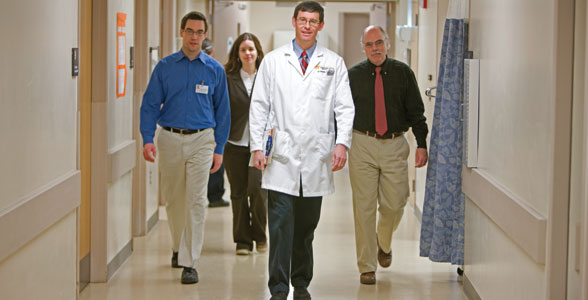It was as simple as telling someone to put the bag of fingers where the patient didn’t have to look at them. That, and having someone like Nicole Perez to know what was causing the patient, a 7-year-old boy, to be inconsolable. Perez (Knoxville ’04, ’06) is pursuing a Ph.D. in clinical psychology at UT Knoxville and taking part in a program that’s putting the campus on the leading edge of clinical psychology training.
She and two other doctoral students are part of the emergency trauma psychology resident program, which brings together resources from UT Knoxville, the UT Graduate School of Medicine, and the UT Medical Center in Knoxville. There’s no other program like it in the country, and thus far, it’s been a resounding success.
About 10 years ago, UT Knoxville psychology professor Michael Nash planted the seeds of a program like this with Reverend George Doebler, the former director of pastoral care at the medical center and now a special advisor to the department. At first, the idea seemed like a stretch, but over time they became convinced of its potential value.
“Psychologists usually hear about trauma from patients years after it happens,” Doebler says.
By exposing students to the all-too-real world of the emergency room, they reckoned, the students could gain experience that would pay off when the time came for them to enter practice. As they saw it, the students, who would have to be very advanced in their studies, could aid in three scenarios:
- First, with patients who come to the emergency room with a psychiatric condition–those who are actively suicidal, for instance
- Second, with patients and their relatives who have experienced significant trauma, to help facilitate the medical process (In many cases, the events that lead someone to a Level 1 trauma center carry large emotional burdens. “There are really tragedies unfolding in there every day,” Nash says.)
- Third, with patients whose medical problems may arise from psychological issues, making time to follow up with patients–a radical change from the standard practice of an emergency room, where practitioners focus necessarily only on current patients
But the hospital’s medical staff required a lot of convincing.
“I’m kind of a cynical guy,” says Dr. Kip Wenger, the medical director of the center’s emergency department. It’s a phrase he says in a way that makes you take him at his word.
When he was first approached about starting the program, he immediately began asking questions: Why was it needed? Would it add to the level of care? Who would supervise it? Perhaps the most important question was more fundamental: Where, in the crowded and chaotic environment of a trauma center, would you put a psychologist?
Wenger agreed to the program on a trial basis, and Perez’s work was the key to persuading him and his team that it really was of value to them and, more important, to patients.
“It was as much an eye-opener for [the staff] as for anyone else,” Wenger says. “Resuscitation is more than just the body, and this program has forced us to reevaluate all the parts of our care.”
Knowing that she had been accepted as part of the team in the ER–an environment that is not known for easily integrating outsiders–was a pivotal moment for Perez.
“It’s an intimidating environment for sure,” she says. “[To be accepted] was a relief for me, and it was a huge step forward for the program.”
 All of the people involved in the program point to a story that exemplifies the difference Perez and colleagues Lina Schlachter and Chris Nicholas have made in the ER. The story starts with a common scene–a child shutting a door on his fingers. Unfortunately for the 7-year-old, the door closed with such force that some of his fingers were severed. In keeping with proper medical procedure, the detached digits were placed on ice in a plastic bag and kept by his side throughout the boy’s trip to the emergency room.
All of the people involved in the program point to a story that exemplifies the difference Perez and colleagues Lina Schlachter and Chris Nicholas have made in the ER. The story starts with a common scene–a child shutting a door on his fingers. Unfortunately for the 7-year-old, the door closed with such force that some of his fingers were severed. In keeping with proper medical procedure, the detached digits were placed on ice in a plastic bag and kept by his side throughout the boy’s trip to the emergency room.
When he arrived at the hospital, emergency staff found him to be completely inconsolable and unable to interact with the doctors and nurses helping him. They called in Perez to evaluate the situation. That’s when she noticed the bag of detached fingers sitting next to the young patient.
Perez suggested that the fingers be moved out of sight so the child would not focus on them–something that the medical staff hadn’t considered as they concentrated on providing medical care to the boy. Perez then had the boy retell the story of what happened. She knew that in the process of doing so, the boy could move beyond the sheer shock of the situation and begin to understand what happened. She also shared with the boy’s parents ways to help him continue to process the incident after he left the hospital.
Thanks to Perez’s help in calming the boy, the emergency room staff was able to successfully reattach the fingers.
These seem like simple solutions, but as Nash put it in retelling the story, “You have to think on your feet all the time in these situations. It’s only in the trenches that you gain credibility. We knew the program was working when they came to us and said, ‘We need more Nicoles.'”
Unique in the nation, the residency program has provided Perez and the other students with an opportunity they say will be useful not just in dealing with trauma immediately but also in working with patients who are processing trauma months and years later. Perez points to the story of a young patient who lost his life in a motorcycle accident. In her clinical role she was immersed in the full sensory experience of his mother coming to grips with her loss.
“There’s nothing similar to the sound of a mother who has lost her child,” she says. “There are no words for it.”
In the future, as she works with patients who have been through similar experiences, Perez says she’ll be better able to relate to what they went through–something that will make her a better psychologist.
“This is what the world is like,” she says. “We need to be capable of working in this kind of setting.”
As Doebler puts it, “The experience will affect the way you treat people for the rest of your career.”
Besides being an educational experience for the students involved, the program also serves as a way to use the psychology resident to help train staff in the hospital setting, both formally and informally. Residents are able to ensure that a patient’s psychological care is part of how a course of treatment unfolds, which changes the typical dynamic of the emergency room.
“Their presence enhances the situation,” says Nash. “Subtleties like that can make a huge difference.”
The psychology residents also play a role in helping emergency room staff process some of the traumatic scenes they face every day–scenes that, for some people not used to the experience, would be completely overwhelming.
Funded by a grant from the Lucille S. Thompson Foundation, the program is having an impact both on the UT Knoxville psychology program and on the work of the medical center. The residency has been extended, and more students are taking part.
“The most exciting things happening at a university are around the edges, the way the university interacts with the community,” Nash says. “In this case, it’s where the university’s mission for excellence in professional training intersects with its commitment to first-rate medical care.”
At its core, though, the psychology resident program’s mission is to train psychologists while ensuring better care for emergency patients–a mission Nash and others feel they are accomplishing.
“This is the best thing I’ve been involved with in a while,” he says. “It’s good medical care, and it’s just the right thing to do.”



